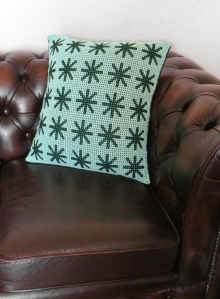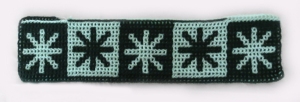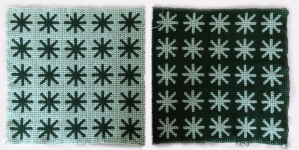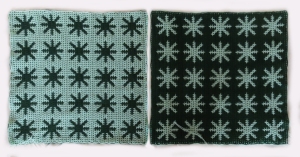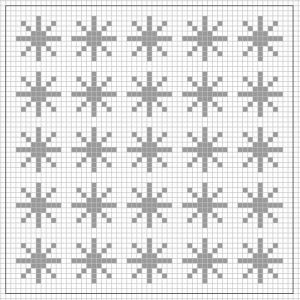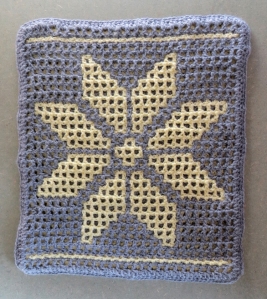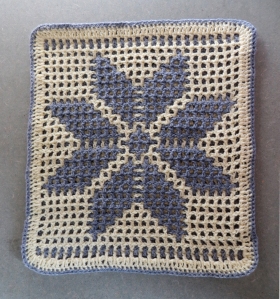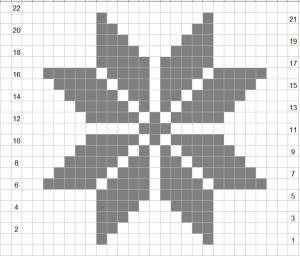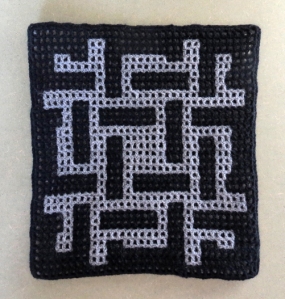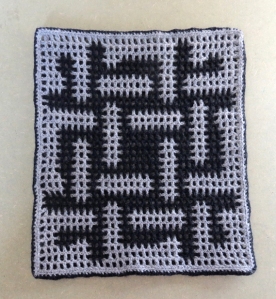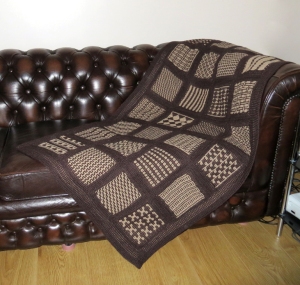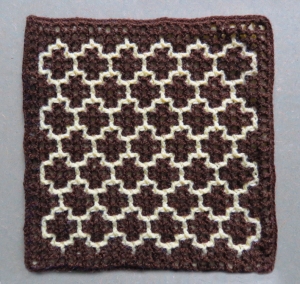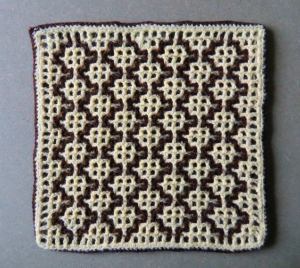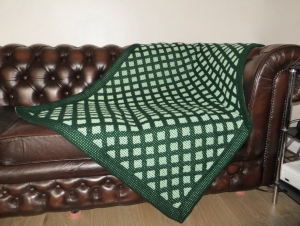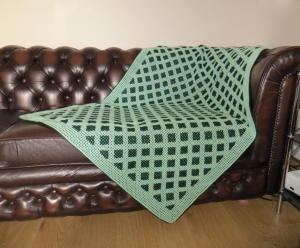Whilst looking for a project to use up the yarn left over from my “Peppermint Passion” Afghan, I found this lovely chart design called Snowflakes at http://free-filet-crocheting.wz.cz/61-80/61.htm.
I had initially intended just to work a sample of the chart, complying with the colour changes in design. However, after completing one pattern repeat…
I decided the design would make a great cushion/throw pillow but I wanted a different coloured background on each side; one side Peppermint with Bottle green snowflakes, and the other side Bottle green and Peppermint snowflakes. The chart required no tweaking. The design was very easy to follow and I think it turned out pretty well. As usual, choosing which side of the fabric was going to be side A was very difficult, as most intermeshed fabric is equally lovely on both sides.
My cushion measures 20” X 20” but this can be changed by increasing or decreasing the number of pattern repeats as required (I always work a swatch prior to starting any project).
To make my Cushion/Throw pillow:
Yarn Type: 4 ply Acrylic machine knitting yarn, left over from a previous project.
Needles: 3.00mm crochet hook.
Cushion/pillow pad 20” X 20” (firm over stuffed)
Method: For the front of the cushion/pillow, work a foundation row of 72 cells in colour A and 71 cells in colour B, and follow the chart for 5 repeats across then continue until work is 5 repeats high.
Finish all four edges; with colour A working through both filet layers ch1, work sc evenly around all four edges, working 2 sc in each filet cell and 4 sc in each corner. Join with a sl st in top of beginning ch, Fasten off.
For the back of the cushion/pillow, work in the same manner as for the front, reversing colour A and colour B.
Join sides; with front and back together and side A facing, with colour A and working through back and front ch1, work sc through each surrounding sc until three sides are joined together, then insert the pad and continue around to join fourth side; sl st in top of beginning ch, Fasten off and weave in ends.
I did not create an opening to remove the cover for cleaning. Both the yarn and pad are synthetic, making the whole thing machine washable.
Update 07-01-2015: As requested in the comments section of the Flower Motif post (https://grippingyarns.wordpress.com/2014/06/23/flower-motif-intermeshing-double-filet-crochet-interlocking-crochet/), I have written out the pattern for one snowflake motif. However, writing patterns in this way is very time-consuming, considerably moreso than actually creating the motif itself! This is not something that I would normally write for the blog, but I am making an exception in this case. After all, it was a request at Christmas.
Each filet layer is worked separately and meshed together (they are never connected, stitches of one layer are never trapped by the other. Stitches are worked wholly in front or behind the other layer). This sometimes requires inserting the hook through a cell of one layer to reach the next double crochet of the other layer. This double crochet is then drawn through to the back or front as required then worked as normal.
Abbreviations
dcif (double crochet worked in the front post)
dcib (double crochet worked in the back post)
ch (chain)
dc (double crochet)
Foundation Row Col B: Work a row of filet mesh consisting of 13 cells, place last loop on stitch holder and set aside
Foundation Row Col A:Work a row of filet mesh consisting of 14 cells
Place colour A layer on top of colour B layer, with working yarn of both pieces to the right (I usually hold the two layers together in the middle with a split ring stitch marker as this stops the pieces twisting)
Row 1 Col A: ch4 (counts as first dc, and ch-1 sp) dcif in next dc. *[ch1, dcif in next dc] 5 times, ch1, dcib in next dc, *[ch1, dcif in next dc] 6 times, ch1, dcif in last dc.
Row 1 Col B: ch4 (counts as first dc, and ch-1 sp) dcib in next dc. *[ch1, dcib in next dc] 4 times, *[ch1, dcif in next dc] twice *[ch1, dcib in next dc] 5 times, ch1, dcif in last dc.
Turn work
Row 2 Col A: ch4 (counts as first dc, and ch-1 sp) dcib in next dc, ch1, dcib in next dc, ch1, dcif in next dc, *[ch1,dcib in next dc] 3 times, ch1, dcif in next dc, *[ch1,dcib in next dc] 3 times, ch1, dcif in next dc, *[ch1, dcib in next dc] twice, ch1, dcib in last dc.
Row 2 Col B: ch4 (counts as first dc, and ch-1 sp) dcif in next dc, *[ch1, dcib in next dc] twice, *[ ch1, dcif in next dc] twice,*[ch1,dcib in next dc] twice, *[ch1, dcif in next dc] twice, *[ch1,dcib in next dc] twice, ch1, dcif in next dc, ch1, dcif in last dc.
Turn work
Row 3 Col A: ch4 (counts as first dc, and ch-1 sp) dcif in next dc, ch1, dcif in next dc, *[ ch1, dcib in next dc] twice, *[ ch1, dcif in next dc] twice, ch1, dcib in next dc, *[ ch1, dcif in next dc] twice, *[ ch1, dcib in next dc] twice, *[ ch1, dcif in next dc] twice, ch1, dcif in last dc.
Row 3 Col B: ch4 (counts as first dc, and ch-1 sp) dcib in next dc. ch1, dcib in next dc, *[ch1, dcif in next dc] twice, ch1, dcib in next dc, *[ch1, dcif in next dc] twice, ch1, dcib in next dc, *[ch1, dcif in next dc] twice, *[ch1, dcib in next dc] twice, ch1, dcib in last dc.
Turn work
Row 4 Col A: ch4 (counts as first dc, and ch-1 sp) dcib in next dc, *[ ch1, dcib in next dc] twice, *[ ch1, dcif in next dc] twice, ch1, dcib in next dc, ch1, dcif in next dc, ch1, dcib in next dc, *[ ch1, dcif in next dc] twice, *[ ch1, dcib in next dc] 3 times, ch1, dcib in last dc.
Row 4 Col B: ch4 (counts as first dc, and ch-1 sp) dcif in next dc, *[ch1, dcif in next dc] twice, *[ch1, dcib in next dc] 6 times, *[ch1, dcif in next dc] 3 times, ch1, dcif in last dc.
Turn work
Row 5 Col A: ch4 (counts as first dc, and ch-1 sp) dcif in next dc, *[ ch1, dcif in next dc] 3 times, *[ ch1, dcib in next dc] 5 times, *[ ch1, dcif in next dc] 4 times, ch1, dcif in last dc.
Row 5 Col B: ch4 (counts as first dc, and ch-1 sp) dcib in next dc, *[ch1, dcib in next dc] 3 times, *[ch1, dcif in next dc] 4 times, *[ch1, dcib in next dc] 4 times, ch1, dcib in last dc.
Turn work
Row 6 Col A: ch4 (counts as first dc, and ch-1 sp) dcib in next dc, *[ ch1, dcif in next dc] 11 times, ch1, dcib in next dc, ch1, dcib in last dc.
Row 6 Col B: ch4 (counts as first dc, and ch-1 sp) dcib in next dc, *[ ch1, dcib in next dc] 11 times, ch1, dcif in last dc.
Turn work
Row 7 Col A: ch4 (counts as first dc, and ch-1 sp) dcif in next dc, *[ ch1, dcib in next dc] 11 times, ch1, dcif in next dc, ch1, dcif in last dc.
Row 7 Col B: ch4 (counts as first dc, and ch-1 sp) dcib in next dc, *[ ch1, dcib in next dc] 3 times, *[ ch1, dcif in next dc] 4 times, *[ ch1, dcib in next dc] 4 times, ch1, dcib in last dc.
Turn work
Row 8 Col A: ch4 (counts as first dc, and ch-1 sp) dcib in next dc, *[ ch1, dcib in next dc] 3 times, *[ ch1, dcif in next dc] 5 times, *[ ch1, dcib in next dc] 4 times, ch1, dcib in last dc.
Row 8 Col B: ch4 (counts as first dc, and ch-1 sp) dcif in next dc, *[ ch1, dcif in next dc] twice, *[ ch1, dcib in next dc] 6 times, *[ ch1, dcif in next dc] 3 times, ch1, dcif in last dc.
Turn work
Row 9 Col A: ch4 (counts as first dc, and ch-1 sp) dcif in next dc, *[ ch1, dcif in next dc] twice, *[ ch1, dcib in next dc] twice, ch1, dcif in next dc, ch1, dcib in next dc, ch1, dcif in next dc, *[ ch1, dcib in next dc] twice, *[ ch1, dcif in next dc] 3 times, ch1, dcif in last dc.
Row 9 Col B: ch4 (counts as first dc, and ch-1 sp) dcib in next dc. ch1, dcib in next dc, *[ch1, dcif in next dc] twice, ch1, dcib in next dc, *[ch1, dcif in next dc] twice, ch1, dcib in next dc, *[ch1, dcif in next dc] twice, *[ch1, dcib in next dc] twice, ch1, dcib in last dc.
Turn work
Row 10 Col A: ch4 (counts as first dc, and ch-1 sp) dcib in next dc, ch1, dcib in next dc, *[ ch1, dcif in next dc] twice, *[ch1, dcib in next dc] twice, ch1, dcif in next dc, *[ch1, dcib in next dc] twice, *[ch1, dcif in next dc] twice, *[ ch1, dcib in next dc] twice, ch1, dcib in last dc.
Row 10 Col B: ch4 (counts as first dc, and ch-1 sp) dcif in next dc, *[ch1, dcib in next dc] twice, *[ch1, dcif in next dc] twice, *[ch1, dcib in next dc] twice, *[ch1, dcif in next dc] twice, *[ch1, dcib in next dc] twice, ch1, dcif in next dc, ch1, dcif in last dc.
Turn work
Row 11 Col A: ch4 (counts as first dc, and ch-1 sp) dcif in next dc, ch1, dcif in next dc, ch1, dcib in next dc, *[ch1,dcif in next dc] 3 times, ch1, dcib in next dc, *[ch1,dcif in next dc] 3 times, ch1, dcib in next dc, *[ch1, dcif in next dc] twice, ch1, dcif in last dc.
Row 11 Col B: ch4 (counts as first dc, and ch-1 sp) dcib in next dc, *[ch1, dcib in next dc] 4 times, *[ ch1, dcif in next dc] twice, *[ch1,dcib in next dc] 5 times, dcib in last dc.
Turn work
Row 12 Col A: ch4 (counts as first dc, and ch-1 sp) dcib in next dc. *[ch1, dcib in next dc] 5 times, ch1, dcif in next dc, *[ch1, dcib in next dc] 6 times, dcib in last dc.
Row 12 Col B: ch4 (counts as first dc, and ch-1 sp) dcif in next dc. *[ch1, dcif in next dc] 11 times, dcif in last dc.
Turn work
Row 13 Col A: ch4 (counts as first dc, and ch-1 sp) dcif in next dc. *[ch1, dcif in next dc] 12 times, dcif in last dc. Fasten off.
